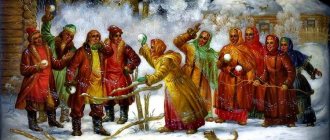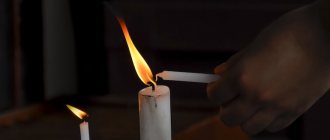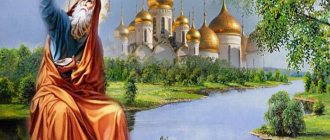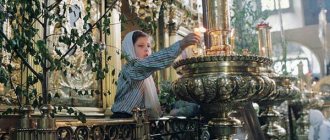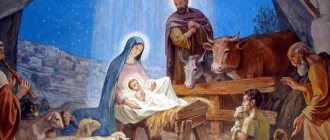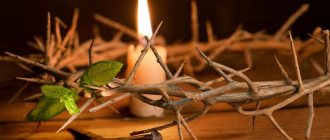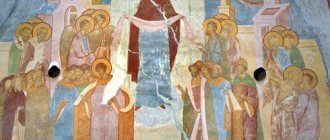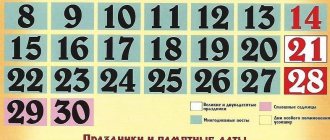Let's try to understand where the name "Christmas Eve" came from? It comes from the word “sochivo” - the main dish prepared for the evening. It has another name – “kutya”, which is more common in Ukraine. It is prepared from steamed or boiled grains of any cereal crops and seasoned with vegetable oil. Now there are many cooking options. Housewives “play” with additives, adding poppy seeds, raisins, nuts, fruits and dried fruits. Each of the symbols represents something: love, prosperity, happiness. The festive dish is always seasoned with honey: so that life in the coming year will be “sweet”.
According to the rules, kutia is a Lenten but festive dish. But the table is not limited to them alone. Believing Christians sit down to the table only once on this day - when the evening service ends and the first star appears in the sky. You can’t eat fast food or even fish; you can eat vegetable oil and red wine. This is according to the strict monastic rules; it is better for Christians to agree on the severity of their own abstinence with the priest, and also read this article about prohibitions and possibilities.
What kind of holiday is Christmas Eve, when and on what date in 2021 in Russia and America
Christmas Eve represents the beginning of a great holiday - the birthday of the Son of God, which is why it is customary to celebrate it with family, relatives and friends. Previously, this was a revered holiday, and from that time on the tradition of gathering with the family on the evening before Christmas began. This is done in order to give each loved one some of your warmth, a gift or just a card with congratulations.
The date of the Nativity of Christ according to the Orthodox calendar is immovable; it falls on January 7 every year. Accordingly, Christmas Eve or the eve of the holiday always falls on January 6th. The date remains constant every year, the number is unchanged, therefore Orthodox Christians celebrate the eve of the birthday of Christ in Russia on this day.
It is known that Catholic Christmas is celebrated earlier, on December 25, due to the difference in dates between the Julian and Gregorian calendars.
This religion is practiced by residents of many European countries and the USA. They celebrate Christmas Eve on December 24th. Not only dates are different, but also traditions; each religion has its own characteristics. Attention!
Christmas on December 25 is celebrated not only by Catholics, but also by Anglicans, Lutherans, Pentecostals and Baptists.
In terms of numbers, there are more representatives of this religion in the world than Orthodox Christians.
Christmas traditions
I would like to note right away that not all Christmas traditions are welcomed by the Orthodox Church; many of them are of purely folk origin. For example, Christmas fortune-telling is strictly prohibited in Orthodoxy, but from century to century people have cast their fortunes on these holy days. In order not to anger God, the girls threw the pectoral cross over their backs or took it off altogether.
The most common Christmas fortune-telling was calling your betrothed through a mirror. This is a very dangerous ritual, during which the girl could get severely frightened. Nevertheless, people used to guess at the mirror and continue to guess to this day.
On a note! The most truthful are considered to be Christmas fortune-telling on the night of January 7, on the night of January 14 and on the night of January 19.
According to popular legends, evil spirits walk freely on the earth until the baptism of Jesus (January 19), so on holy days you can guess and find out your future. These days evil spirits do not harm people, but help. The Church, of course, refutes these beliefs, but they still took root among the people.
The housewives tried to set the Christmas table richly - they prepared 12 different dishes so that they could live without need for the whole year (12 months). According to another interpretation, the 12 dishes on the table symbolize the 12 disciples of Christ - the apostles. But the dishes should not be light; they will certainly be prepared lean.
Note! The main dishes on the Christmas table on Christmas Eve are kutia and dried fruit uzvar. Traditionally, people do not drink water the night before Christmas.
This is a very quiet and bright holiday: Christmas Eve is spent with family, without rejoicing and fun. Candles and a fireplace (if there is one) are lit in the house. It is believed that you need to try all 12 dishes on the table, but you should not overeat.
After the meal you can go caroling. Christmas Eve opens the holy days, which will last until Epiphany. How do you spend Christmas Eve? During caroling, groups of mummers sing Christmas songs (carols) and go from house to house. The owners of the houses treat the carolers with cookies, pies, sweets and fruits. It is impossible to drive away carolers: this is considered a bad omen.
On a note! A special feature of Christmas caroling were the masks and masquerade costumes that the carolers wore.
Masks and costumes for caroling were prepared in advance. Guys and girls sewed such outerwear that they would not be recognizable as carolers. For costumes they took the skins of animals and livestock, straw, scraps of brightly colored fabric, and brushwood. To sew a costume, you just had to use your imagination.
However, it is not carols or the Christmas table that are the central idea of the holiday, but the Incarnation. This should not be forgotten in the pre-holiday bustle, running around the shops with Christmas discounts and giving gifts to friends and family. The essence of the holiday is leisurely, solemn and God-fearing.
God Himself became one of us, took human form and incarnated in a mortal body. This event took place in the supermundane dimension and cannot be measured by any merry songs or carols. All this Christmas fuss and tinsel does not contain the true spirit of the holiday.
In the old days, charity was accepted on Christmas Eve. Food, money and gifts were prepared in advance for the poor and orphans. Prisoners and sick people were not left without attention. The believers were convinced that the hand of the giver would never fail, and they joyfully brought donations to the church.
Why is it called Christmas Eve before Christmas?
The name “Christmas Eve” refers to the eve of a major church holiday, the Nativity of Christ. This date is the last day of fasting; Christian believers rejoiced and prepared for the holiday, eating only special food so as not to violate the rules prescribed by fasting. Most often it was “sochen” - a flatbread made from unleavened dough, seasoned with plant sap (oil). Another dish that has survived to this day is sochivo or kutya, cereals soaked in water or the juice of fruits or herbs. It is believed that the word “Christmas Eve” came from these names.
Previously, this name was used in relation to any religious holiday, now it is used only in relation to the Nativity of Christ and the feast of the Epiphany. Among the people, the Slavic Christmas Eve before the holiday was also called “Holy Evening”. People valued this date and carefully prepared for it. The family gathered in the parental home, and the housewife-mother put festive treats on the table, including kutya.
history of the holiday
In the Orthodox Church, the celebration of the eve of the Nativity of Christ was established in the 4th century. In the 5th-8th centuries, sacred hymns were written that are used for Christmas services. During that period, the Royal Hours were celebrated in churches. At them it was customary to proclaim many years to the Tsar, his house, and all Orthodox Christians.
The name of the holiday comes from the word “sochivo” or “sochni”. Both of these dishes were prepared on Christmas Eve. Sochivo was soaked grains of wheat or barley, to which the juice of poppy seeds, sunflowers, hemp, mustard, and nuts was added. Sochni - bread cakes in which holes were made for eyes and used for fortune telling. They looked out into the street through the mask. It was believed that if a good person passed, the year would be successful, and if a bad person passed, the opposite would be true.
How Catholics celebrate Christmas Eve
We have already figured out that Christians belonging to the Catholic faith celebrate Christmas Eve on December 24th. Regarding this holiday, they have their own traditions and customs:
- On the pre-holiday evening, it is customary for families to decorate the Christmas tree and organize a symbolic manger for the sheep. The doors of the house are also decorated with attributes in the form of wreaths of green coniferous branches - this indicates that the house is awaiting the appearance of Christ.
- Believing parishioners must attend church, listen to prayers and light candles in memory of their ancestors.
- It is customary to involve children of all ages in the traditions of the holiday. They must do feasible work and help adults. For this they receive a reward: a bunch of straw or a small heart made of paper. Before Christmas, they decorate the tree with hearts and put straw in the manger.
- Christmas Eve dinner consists exclusively of lean dishes; fast food can only be eaten on the holiday. A tray with consecrated unleavened bread is placed in the center of the table.
- The head of the family before dinner reads aloud a passage from the Gospel of Luke about the birth of Jesus.
Another custom of Catholic Christmas is widespread. On the festive table on Christmas Eve they put one more device - in the hope that the traveler will knock on the house. Another, similar one - a Christmas tree made of candles is placed on the windowsill, not far from the front door of the house, it also indicates that someone who is hungry and lonely is waiting inside.
Attention!
It is considered a good omen that a lonely traveler appears at home. According to her, only happiness will await the family gathered at the table next year.
Festive table
Particular attention is paid to decorating the table for a family dinner. The housewives prepare a snow-white tablecloth, take out a new set, light candles, and place a small bunch of straw (a symbol of Jesus' manger). Fir branches and bunches of garlic are placed in the center. The culinary celebration takes place among family members, and there is also a tradition of giving the supper to the godparents.
The meal should begin with a prayer of praise glorifying Christ. First they try kutya, after which they begin all other dishes. In Rus', twelve Lenten dishes were placed on the table - in accordance with the number of apostles.
Kutya for Christmas Eve is prepared in advance, since wheat grains are boiled for several hours. Includes:
- whole wheat (can be replaced with rice, barley, millet);
- honey (sugar);
- ground poppy;
- walnuts;
- dried fruits - raisins, dried apricots, prunes, apples.
When midnight comes, you can put meat dishes on the table.
What to do and how to celebrate Christmas Eve before Christmas
Not everyone knows how to spend the evening before Christmas correctly. The main tradition recommends that Orthodox Christians attend church with the whole family. Christmas service is the main tradition, because the holiday is religious. When you come to the service, you can pray for yourself and the health of your loved ones, light candles for the repose of the souls of deceased relatives.
Another tradition recommended staying at home on this day; only girls and young boys went to visit, had fun and told fortunes. But this tradition is far from spiritual, because the church recommends behaving modestly during Lent. It is better to consider the evening before Christmas as a family one, invite friends over or go on a visit with gifts and treats.
It is customary on Christmas Eve to sacrifice one's material possessions for the benefit of those in need. In this case, the chosen method is not important: you can transfer money from the card to the account of a homeless animal shelter, help sick people, or simply feed the homeless. The main thing is to get pleasure from it, that is, to do good with a pure heart, then it will come back.
In the evening before the holiday, it is customary to sing carols, visit godparents and feed them suppers - the traditional Lenten kutya. People who meet the carol must give a gift: money or sweets. Caroling is still considered a good omen, capable of bringing happiness and prosperity to the house.
Bottom line
We learned about how Christmas Eve is celebrated in Orthodox traditions. This is a very bright and joyful holiday, so before Christmas you should forgive your offenders from the bottom of your heart and forget all your sorrows. At Christmas there is a struggle between light and dark forces - and a person makes a choice about who to be with. He who chooses good rejoices on the holiday from the heart. Anyone who is inclined to choose the dark side engages in sorcery and fortune telling. But why guess fate if you can ask God to fulfill your deepest desire on this wonderful night? This wish will certainly come true if it is made from the heart.
How to cook and how to eat on holiday
It is customary to sit down at the table on Christmas Eve only after the first star appears in the sky - it symbolizes the Star of Bethlehem. The Bible says that it was she who illuminated and showed the way for the wise men to the den. Therefore, only after her appearance can the family sit down at the table, at the head of which there must be a rich person.
Before the beginning of the Lenten “supper”, prayers are read, and then kutya is eaten - 3 spoons each. Children should taste it first. In addition to sochiv, there should be 11 more dishes on the festive table, among which the following are obligatory:
- vareniki;
- uzvar;
- lean cabbage rolls with cereal;
- mushroom soup;
- lean borscht or cabbage soup;
- donuts;
- pickles;
- the vinaigrette.
It is recommended to spend January 6th in prayer and fasting. At the same time, he must be strict; he is only allowed to drink water. Dinner starts in the evening. For ordinary parishioners, it is not necessary to observe the tradition of absolute hunger, especially for children, pregnant women, sick and infirm old people.
Interesting to know!
The number of dishes on the table on Christmas Eve should correspond to the number of Christ’s apostles – there are 12 of them.
How to make it luscious?
Our great-grandmothers knew what to cook for Christmas Eve. These ancient recipes for preparing Christmas dishes have not been forgotten. And today, any housewife can cook it juicy if she wants. Here is the recipe for this dish:
- 1 faceted glass of wheat grains.
- 100 g poppy seeds.
- 100 g walnut kernels.
- 1 or 2 tablespoons of liquid honey.
- A little sugar.
Place the wheat grains in a wooden mortar and pound with a pestle until the shell of the grains comes off. In this case, you need to add a little warm boiled water to the mixture. The husks are then removed by washing the grains. Wheat is poured with water, put on fire and boiled until tender. It turns out to be a crumbly porridge. In a wooden mortar, grind the poppy seeds in the same way until milk of the poppy appears. Add it to the porridge, add honey and sugar and mix thoroughly. At the end, crushed walnut kernels are added to the mixture. Sochivo ready.
Traditions and signs of Christmas Eve
All signs, traditions and superstitions are “imbued” with mystery. They arose over many years, so it happened that people noticed certain combinations of circumstances, and then passed on their warnings from generation to generation. Let's consider the main traditions:
- You should not repay debt or lend money on Christmas Eve and at Christmas. This way you can say goodbye not only to wealth, but also to luck, health, and well-being.
- Superstitions do not recommend leaving the house after the stars appear in the sky. It is believed that a person will wander the world restless all year.
- You cannot do handicrafts - sewing, embroidering, knitting. According to one of the signs, the master may go blind, according to the second, he will be haunted by troubles and illnesses all year.
- You cannot take valuables or even trash out of the house in the evening. Prosperity will leave home.
- On a bright religious holiday and Holy Evening, you cannot quarrel with anyone, and use foul language; it is better to remain silent, even in the most unpleasant situation.
On Christmas Eve it is not recommended to do household chores: cooking, washing, ironing, repairing anything, sewing. Everything necessary must be done in the morning or postponed until January 8th. But the church says: “working is not a sin.” The ban on the listed actions is explained by the fact that they can be considered as a valid reason for not visiting the temple, although they are not.
The most popular signs:
- snow, a lot of frost - wait for the grain harvest;
- on the morning of January 6, black paths are visible - buckwheat will crop up;
- sunny weather during the day - early spring;
- snowfall, blizzard - big harvest;
- starry sky - promises a successful year in all endeavors;
- dim milky way - to a bad harvest;
- there are many stars in the sky on the night before Christmas - waiting for the mushroom harvest.
Interesting!
If a man is the first of the guests invited to the holiday to enter the house, the year will be successful; a woman will have to work hard to achieve her goal.
Fortune telling on Christmas Eve
Christmas fortune-telling is popular among girls of different ages. The best period to look into the future is Christmastide (the two-week Christmas holiday starting on Christmas Eve and ending on Epiphany). Why is there a link to these dates? It is believed that the answers from higher powers will be the most plausible.
Remember that fortune telling implies a connection with otherworldly forces, therefore, when performing the ritual, you must follow the rules of precaution. Esotericists distinguish the following:
- there should be complete silence in the room where the ritual is performed, there should be no strangers or sounds;
- complete immersion is necessary, a person must believe that he will receive an answer to the question asked;
- You can’t cross your arms and legs;
- Before the ceremony, you should inspect your clothes, remove knots, unravel your hair;
- Full concentration on the question is important, otherwise you will not be able to get a clear answer.
Let's consider 3 main options for fortune telling on Christmas Eve:
- By the barking of dogs. At night you need to go outside, take a fork or a small knife and start cutting the snowdrift with a tool. During the process, you need to cast a spell: “I can’t bear to sit at home on this magical night. Someone calls my soul outside to tell me what fate awaits me. Strength, give me the answer whether happiness awaits or not.” There is no need to rush to go home; first you need to wait for the dog to bark. If he is soft and quiet - everything will be fine, if he is angry and growling - expect difficulties. The worst prediction awaits those who hear the howl - trouble is possible.
- On the water. For fortune telling, you will need 3 identical glasses; they are filled with water and added: honey, lemon juice or acid, salt and wine. The tray is covered with a towel and rotated, and then the fate is determined according to taste (the glass is taken without looking). Honey promises a sweet and carefree life, salt promises a lot of tears, lemon promises melancholy, wine promises pleasant and unexpected surprises.
- Ice divination. At midnight on Christmas Eve, water is poured into a saucer and placed on the porch of the house. The result is assessed in the morning. A smooth surface is good, the appearance of cracks is a sign of change (not always good), a wave is unlucky, the formation of a hole is a sign of trouble and disappointment.
Attention!
The Orthodox Church does not recommend performing such rituals, especially on religious holidays, in the belief that this is a sin. There is no need to deceive fate, everything has its turn.
Congratulations in pictures and cards for Christmas Eve
On Christmas Eve, it is customary to invite guests to your home: relatives, loved ones, friends and just acquaintances. Regular postcards have practically gone out of use and have been replaced by beautiful electronic cards and pictures. In this collection you can find options appropriate for congratulating loved ones on the holiday, and to make the congratulations doubly pleasant, do not forget to add a few lines with warm words, written yourself.
How to congratulate friends nearby and at a distance is up to you, and we will help you choose the best congratulations. Remember, warmth and kindness should emanate from them - this is valuable. A suitable postcard can be printed on photo paper or sent to a person on social networks or via instant messenger.
Christmas Eve is the eve of the Nativity of Christ, which occurs on January 6 for the Orthodox population, and on December 24 for Catholics. Not only do the dates of these holidays differ, which is due to the use of different calendars, but also the traditions honored by religious citizens. I would like to note that many of the rules that have come down to us are refuted by the church, therefore it is not necessary to follow them. As the church says, the main thing is to celebrate the bright holiday of the Nativity of Christ with warmth and joy in your heart, to be pure before the Lord.
Christmas Eve: about prayer, about the Bible, about food
The Virgin today the Eternal Word in the den is coming to give birth ineffably: rejoice, universe! (From the Christmas Eve kontakion)
In popular culture, the one that comes from Hollywood, Christmas Eve is a cozy family holiday. On Christmas Eve or right on this day, they decorate the Christmas tree, buy gifts, and set a special table. Turkey, goose, spicy Christmas pastries, Christmas carols... Day of peace, love, family (traditional family, it is worth emphasizing), day of miracle. And in our difficult times, these Western Christmas Eves are a sign of hope. Traditions are not forgotten, and these traditions look towards Christian culture, at least from afar they remind us of faith.
Both our folklore and our Russian genius, who sang the quiet Ukrainian “Night before Christmas,” remind us that Christmas Eve is a special day.
But we want to celebrate not just a “traditional family holiday”, but the Birth of the Savior of the world. And not just “celebrate” - but spend this day with the Church. But at the same time, we still offer children a truly bright holiday that will be remembered for a lifetime, which will remind our children of the true joy of childhood, of the joy of life in the Church, wherever they find themselves in their adult lives.
In general, I have already written about Christmas Eve, about preparations for Christmas. And here I will try to separately and in detail consider how you can do two important things on this day - take spiritual food and ordinary food.
Christmas Eve service
Christmas Eve is, of course, a Christmas tree, balls and garlands, a gingerbread house on the window, preparing gifts... - and all this is happy, childish, what makes the holiday a Holiday. But first of all, this is the completion of our path to the Nativity of Christ, the path that continued throughout the Nativity Fast. And so as not to turn the Christmas tree and gifts into the main or even the only meaning of this holiday, so that we ourselves do not forget in the cleaning, cooking and festive bustle for which, in fact, we are trying so hard, it would be good to remember the service of this day.
Christmas Eve begins not with the preparation of gifts or with the preparation of salads, but with the reading of the Great, or Royal, Hours
And the service today is special. The eve of Christmas in our Church begins not with the preparation of gifts or even with the preparation of salads, but with the reading of the Great, or Royal, Hours, as well as with Vespers - also Great, and then - the Liturgy of Basil the Great. These services figuratively and vividly show the meaning and significance of the Nativity of Christ, preparing us all to meet the Newborn Savior.
The service of the Royal Hours is performed twice more a year: on the eve of Epiphany and on the morning of Good Friday - special, sacred, great “times and seasons” of both Sacred history and our lives.
These clocks are called royal because in Byzantium the emperor was present at this service:
“In front of a special ark with the holy icon of the Nativity of Christ... there is a lectern on which the Holy Gospel is placed. The clergy in sacred vestments, clergy and officials of the Court are located here in anticipation of the king. Its appearance has been welcomed for many years. The king kisses the holy icons and stands near the throne. After this, the singing of the hours begins... Having read the troparion, the canonarch says: “God will create your (or your) kingdom, which is named by God, crowned by God and observed by God, sovereign and holy for many years.”[1].
Nowadays, in many churches, a nativity scene made of fir branches and flowers is installed on a lectern, which, like the walls of a cave, overshadows the icon of the Nativity of Christ. In front of this nativity scene are priests in white robes, with candles - almost like angels with stars! - they read the prophecies about the Birth of the Savior and remind us again and again:
Now the prophetic prophecy will be fulfilled and coming!..[2]
Now - right now, at this winter dawn of Christmas Eve.
And we, together with the children, can come to the temple this morning and see how it goes to Bethlehem
Miriam, womb-bearers of seedless birth,
feel:
it's Christmas time,
understand why Christ is born: to
resurrect the image that was previously fallen.
After the hours, Great Vespers is served: Christmas stichera are sung, eight proverbs - Old Testament prophecies - are read.
These are all incredibly important, amazing words, deep images. All this is real preparation for the Nativity of Christ, this is what it is, and not the preparation of a Christmas goose or pig. All this in itself is education for both children and parents. Such participation in worship in general is the notorious “religious education.”
But it often happens that we may come to the service, and the mood will be prayerful, and there will be an impression of the upcoming holiday - but we simply will not hear the content of these texts. For example, the choir will sing beautifully, but unintelligibly, the reader will read too quietly, and the priest will read incomprehensibly. Unfortunately, this happens. You have to guess the content of this reading from scraps of phrases... What can we say about children!
In general, in order to fully participate in the divine service, it is good to go with your children to a church where they read clearly.
Another option, which in any case is important and works: give books with texts to children who read and take them themselves. It is especially good if the book contains not only text, but also explanations and translations. Such books are now being published and sold[3].
But it happens that it is impossible to come to the temple for this service. Children 2-3-5 years old may simply not allow their parents to pray. And it is not always useful to bring children 7–10 years old to church for the entire service: instead of focusing on the service, such children will draw or read books in the church shop, while their parents... shake a crying baby in the street. However, even in this mode, it is still useful to come to church and at least somehow join in the common prayer. But here we must keep in mind: we still have the all-night vigil, night or morning Liturgy of the very feast of the Nativity of Christ ahead. And when there are babies and primary schoolchildren in the family, it can be an unjustifiable burden for both children and parents to come to church for all these services. And as usual, as always, you have to choose one thing. And take into account that all of us - children, teenagers, fathers, and pregnant and nursing mothers - definitely need to get enough sleep on the eve of the Christmas Liturgy.
Home Worship on Christmas Eve Morning
If you can’t come to church with your children for hours, vespers and Liturgy, then you can still celebrate this day well with prayer. The special prayer with which our Church invited us to celebrate Christmas Eve. And by reading the Holy Scriptures, which the holy fathers also offered us today.
I have already written about how and why you can read a church service at home with your children. Here I will try to talk about what options there may be – just options! – home worship on Christmas Eve.
It seems to me that you can involve children when the eldest is 8–9 years old. And while the youngest participant is under 10, there is little prayer, not for long.
Then, over time, when the children grow up, we all, already well aware of this service, already accustomed to celebrating Christmas Eve this way, will be able to actively and consciously participate in the church service of this day. Actually, that’s what it’s all about.
To arrange all this, you don’t need much: light a candle or lamp in front of the icons, maybe some incense. Prepare the text of the service - buy in advance or download on the Internet at the request “Text of the service for the eve of the Nativity of Christ.”
The beginning is usual: initial prayers.
And then we read something from the clock. For example, together with the children we will call: “Bethlehem, get ready, manger, decorate yourself!”
Bethlehem, get ready, beautify yourself, manger, den, receive: The truth has come. The shadow passed by, and God appeared as a man from the Virgin, imagining himself like us and deifying the flesh. Thus Adam is renewed, calling with Eve: good will appear on earth to save our race.
Everything is clear, except for “the shadow of the moment” - something like “the darkness has passed.” Older children can, taking turns with their parents, read these chants aloud during our common prayer.
If we are going to read for a short time, we can immediately read the Gospel of the third hour - Luke. 2:1–20. Familiar even to little ones - how the Mother of God swaddled and laid her Newborn Son in a manger, how an angel appeared to the shepherds. You can read it directly in Slavic, or you can read it in the Synodal translation - it depends on the age of the children. You can prepare picture books about Christmas in advance, maybe a children's Bible. And while the older children listen to the Gospel, the younger ones can look at the drawings with the same plot. And this reading of the Gospel is a unique opportunity to prepare children for the holiday... through prayer.
Reading from the Gospel about the Nativity of the Savior is a unique opportunity to prepare children for the holiday... through prayer
Thus, the gospel stories turn towards prayer and show that all these are not only historical events. Everything described in the Gospel mysteriously happens here and now.
This point can be emphasized and told to the children: today, that is, literally today, the Virgin goes to the den to give birth there to the Child Mlado, the Eternal God:
The Virgin today, the Eternal Word in the den, is coming to give birth inexpressibly: rejoice, the universe, having heard, glorify with the Angels and shepherds the One who wants to appear, the Young Child, the Eternal God.
It seems to me that it is also very good to sing or read the amazing stichera of the ninth hour, which both in form and content resembles the antiphon of the Good Friday service:
Today is born from the Virgin with the hand of the whole creation, wrapped in swaddling clothes, like the earth, Whose being is inviolable to God. In the manger he reclines, having established Heaven with words at the beginning, and feeds on milk from the breasts, who in the desert rained manna upon the people, the Church Bridegroom calls the Magi, and the Son of the Virgin receives these gifts. We bow to Your Nativity, Christ; We bow to Your Nativity, Christ; We bow to Thy Nativity, O Christ: show us also Thy Divine Epiphany.
At the end of this chant, when we say “we bow,” we all bow together.
And now you can read the Gospel again: we combine the reading of the sixth and ninth hours - Matt. 2:1–12 and Matt. 2: 13–23. About the Magi, the star and King Herod. This is most likely again a plot very familiar to children, so it will be understandable even in Slavic. However, if children are little familiar with church culture, it seems to me that it’s good to first read in the Synodal translation, this is certainly better than limiting oneself to retellings from children’s books.
This could be the end of such a short service, but still a service.
Is it possible by
